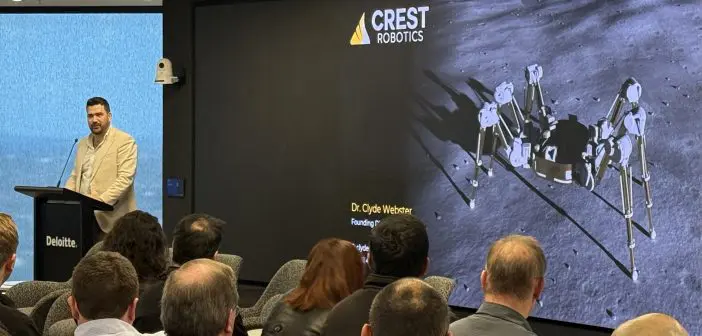
From Spiders to the Moon: Crest Robotics’ Bold Vision for Sustainable Space Construction
Chris Cubbage, Editor
At last week’s New Horizons Summit in Sydney, Crest Robotics took to the stage with what was the most striking prototype of the conference: a giant robotic spider. Addressing the “elephant-sized spider in the room,” Founding Director, Dr Clyde Webster (pictured), initially made light of what is a serious piece of engineering and sets a bold vision for Australia’s role in the next phase of lunar exploration.
Crest Robotics is part of a new wave of companies looking to apply Australian ingenuity to off-world construction. Backed by a half-million-dollar grant under the NSW Government’s ‘Spark Space+ program’, the team is working on robotic systems capable of building sustainable shelters on the Moon. Their work combines lunar dust mitigation, robotic construction methods, and automation techniques first imagined for Earth, but now finding a natural application in the extreme environment of space.
The Dust Problem
If humans are to establish a permanent presence on the Moon, the first challenge is not water or air, but dust. NASA has long identified lunar dust mitigation as a top priority. The fine, electrostatically charged particles can clog machinery, damage seals, and endanger astronauts. Crest Robotics’ engineers reached the same conclusion: before we can dream of habitats, starships, or lunar mining, we need infrastructure that manages dust and protects equipment.
Their solution is elegantly simple: start small. Instead of landing massive vehicles straight onto the regolith, smaller autonomous machines can first prepare the ground. By collecting loose dust and compressing it into bags, machinery can create structural layers, build roads, and form protective shelters. The approach borrows from a century-old technique known as ‘earth bagging’—traditionally used on Earth to build durable, low-cost housing. Translated to the Moon, it becomes “moon bagging,” a sustainable way to turn dust into infrastructure.
Spiders as Builders
Crest Robotics’ prototype spider is more than a marketing gimmick. Its six-legged form solves a real engineering problem: how do you pack maximum construction capability into the smallest, most portable platform? Traditional large-scale 3D printers require gantries or hydraulic arms as big as the buildings they construct—completely impractical for lunar missions. A spider-like robot, by contrast, can fold compactly for transport, then deploy to extrude and compact lunar soil into domed shelters.

Crest Robotics – Spider Robot
Unlike conventional heavy machinery, Crest’s designs rely on electric actuators, giving the robots a higher strength-to-weight ratio and greater agility. Dr Webster explained it with a simple analogy: humans don’t rely on bulk to dig with a shovel; we use balance and dynamic movement. The same principle applies to these lightweight robots, which can lift three times their own weight while remaining agile enough to operate in low gravity.
The vision is iterative. The first prototypes will demonstrate wall-building and dust collection. Later versions, scaled up to three or four metres tall, will climb their own structures, progressively constructing taller and more complex domes. These shelters, while initially intended for machinery and equipment, could evolve into habitats for astronauts.
Terrestrial Spin-Offs
Although the lunar application grabs headlines, Crest Robotics is equally focused on Earth. The company sees its technologies as solutions to dangerous, repetitive, and high-risk work in industries ranging from construction to mining.
Earth bagging, while labour-intensive today, could be revolutionised through Crest’s mechanisation. A small team of engineers recently took an hour and a half to build a single wall segment manually. With automation, Crest believes a full house could be completed in a day—offering a pathway to sustainable, low-carbon housing at scale. Once rendered, such homes could look indistinguishable from a standard Australian build, but with a fraction of the carbon footprint.
The company also showcased other robotic platforms, such as the “Emu” designed for confined spaces and height work. Drawing inspiration from biology—including bird locomotion studied during the Dr Webster’s PhD—these machines adopt spider-like forms that are naturally suited to climbing, crawling, and navigating tight environments.
This dual-use philosophy—designing robots for hazardous Earth-bound industries and adapting them for space—provides commercial viability today while keeping an eye on tomorrow’s lunar economy.
Australia’s Role in Space
Crest Robotics’ work also feeds into a broader conversation: what narrative should Australia adopt as it seeks to expand its space industry? The nation is recognised globally for its expertise in remote operations and resources management. Dr Webster argues that these strengths should be framed around something tangible and relatable: housing.
Pitching “lunar housing” may sound far-fetched, but it resonates strongly in the current environment with Australian politicians and the public in ways that abstract discussions of space hardware often do not. If Australia can develop robotic systems that build homes on Earth more safely and sustainably, the leap to homes on the Moon becomes an extension of that story.
The company is actively seeking partners to help develop, test, and scale its technologies. By the time of the upcoming 76th International Astronautical Congress in Sydney this October, Crest hopes to unveil a fully functioning spider robot, complete with integrated extrusion and compaction systems.
The First Space Mechanics
Dr Webster also made a somewhat foreseeable prediction: the first job title on the Moon won’t be miner or scientist, but “space mechanic.” Autonomous robots may be reliable, but maintaining a permanent lunar presence will require humans trained to service and repair them. Crest’s engineers see their role as laying the groundwork for that future.
In the meantime, the company remains focused on its dual mission. On Earth, it aims to eliminate workplace injuries through robotics—its mantra is “a robot for every tradesperson.” Off Earth, it is preparing for the moment when Australia’s machines help build the first sustainable lunar shelters.
Whether the spider prototype becomes an icon of Australian space innovation or simply a stepping stone, one thing is clear: Crest Robotics is pushing the boundaries of what construction means, both here and beyond our planet.
MySecurity Media: Space and Defence News are media partners to IAC, 2025.





